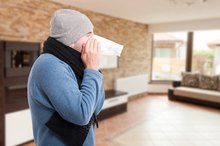What does fact checked mean?
At Healthfully, we strive to deliver objective content that is accurate and up-to-date. Our team periodically reviews articles in order to ensure content quality. The sources cited below consist of evidence from peer-reviewed journals, prominent medical organizations, academic associations, and government data.
- Therapeutics and Clinical Risk Management: A Review of Nasal Polyposis
- Therapeutics and Clinical Risk Management: A Review of Nasal Polyposis
The information contained on this site is for informational purposes only, and should not be used as a substitute for the advice of a professional health care provider. Please check with the appropriate physician regarding health questions and concerns. Although we strive to deliver accurate and up-to-date information, no guarantee to that effect is made.
Bump on the Inside of the Nose
If you have a bump inside of your nose, it's probably not something serious. Most commonly, this bump is a nasal polyp, pimple or a boil -- or sometimes an insect bite. Infrequently, the bump leads to a serious infection, and rarely, the bump is cancerous. So if the bump doesn't go away within a few weeks, or if the swelling or pain is severe, see your doctor.
If you are experiencing serious medical symptoms, seek emergency treatment immediately.
Nasal Polyps
A bump inside the nose may be a nasal polyp, which is an abnormal growth on a mucous membrane -- such as the lining of the nostrils. These growths are related to inflammation, which is why they are more frequently seen in adults with asthma or allergies. Polyps may occur temporarily, during nasal or sinus infections, or they may be a permanent bump inside the nose. Nasal polyps can lead to a runny nose, congestion, postnasal drip, itching around the eyes, decreased sense of smell or taste, headache or snoring. Treatment options include shrinking the polyps with steroid drops, sprays or tablets, or surgical removal if steroid treatment is contraindicated or unsuccessful.
Folliculitis
What Is a Nasal Bone Spur?
Learn More
This infection can be triggered by a break in the skin, caused by dryness, nose picking or trauma, or may be caused by a blockage of the follicle. This bump is usually red and irritated, and may secrete pus.
Other Causes
Furuncles are usually caused by the bacteria Staphylococcus, and typically require antibiotic treatment to prevent a more serious infection that may get into the blood. Rarely, a bump in the nose is a malignancy, although nasal and sinus tumors account for only 1 percent of all cancers.
Warnings
Certain Cancers That Cause Nosebleeds
Learn More
Any bump in the nose that does not heal after 2 weeks should be evaluated by a doctor. Also, see your doctor to evaluate any persistent nasal symptoms, including congestion, runny nose or post-nasal drip, ongoing facial pain, swelling, fever, or recurrent or severe bleeding from the nose.
Reviewed by Kay Peck, MPH RD
Related Articles
References
- Merck Manual: Bacterial Nasal Infections
- Merck Manual: Folliculitis
- Therapeutics and Clinical Risk Management: A Review of Nasal Polyposis
- National Institutes of Health: National Cancer Institute: Paranasal Sinus and Nasal Cavity Cancer Treatment (Adult)
- American Academy of Allergy, Asthma, and Immunology. Nasal Polyps.
- National Institutes of Health. MedlinePlus. Nasal Polyps. Updated August 12, 2019.
- Bachert C, Han JK, Desrosiers M, et al. Efficacy and safety of dupilumab in patients with severe chronic rhinosinusitis with nasal polyps (LIBERTY NP SINUS-24 and LIBERTY NP SINUS-52): results from two multicentre, randomised, double-blind, placebo-controlled, parallel-group phase 3 trials [published correction appears in Lancet. 2019 Nov 2;394(10209):1618]. Lancet. 2019;394(10209):1638‐1650. doi:10.1016/S0140-6736(19)31881-1
- Astrazeneca. Three clinical trials announced for Fasenra in eosinophil-driven skin diseases.
Writer Bio
Lindsay Boyers has a Bachelor of Science in nutrition from Framingham State College and a certificate in holistic nutrition from the American College of Healthcare Sciences. She is also a licensed aesthetician with advanced training in skincare and makeup. She plans to continue on with her education, complete a master's degree program in nutrition and, ultimately, become a registered dietitian.







